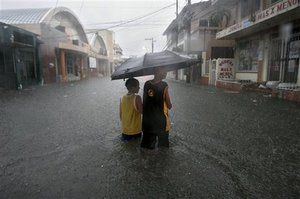Atlantic and Pacific hurricanes making landfall on the same day is unprecedented, according to National Hurricane Center records dating back to 1949.
Felix roared ashore before dawn as a Category 5 storm along Nicaragua's remote northeast corner - an isolated, swampy jungle where people get around mainly by canoe. The 160 mph winds peeled roofs off shelters and a police station, knocked down electric poles and stripped humble homes to a few walls.
"The metal roofs are coming off like straight razors and flying against the trees and homes," Lumberto Campbell, a local official in Puerto Cabezas, near Felix's landfall, told Radio Ya shortly before his phone line went dead.
Emergency official Samuel Perez said most of the port's buildings were damaged and the dock was destroyed, although there were no reports of deaths.
By late afternoon, Felix had weakened to a Category 1 storm with winds of 75 mph. But forecasters were still worried that the tempest would do great damage inland over Honduras and Guatemala, threatening mudslides. Up to 25 inches of rain was expected to drench the mountain capitals of Tegucigalpa and Guatemala City, where shantytowns cling precariously to hillsides.
Towns across Honduras were flooding, and residents waded through waist-deep, garbage-strewn water in La Ceiba, on the northern coast.

|
| ©AP Photo/Esteban Felix |
| People wade through a flooded street in La Ceiba, Honduras, Tuesday, Sept. 4, 2007, caused by the passing of Hurricane Felix. |
In 1998, Hurricane Mitch parked over the same region for days, causing deadly flooding and mudslides that killed nearly 11,000 people and left more than 8,000 missing.
"The major concern now shifts to the threat of torrential rains over the mountains of Central America," said senior hurricane specialist Richard Pasch at the National Hurricane Center in Miami.
In the Pacific, Henriette's top winds increased to 85 mph and it made landfall just after 2 p.m. on the southern tip of Baja, a resort area popular with Hollywood stars and sports fishermen. Few tourists or residents had expected much trouble, but they awoke Tuesday to dangerous winds, closed airports and forecasts of a direct hit.
"I've been hearing it from the wife, coming to Cabo during the hurricane season," said Derek Dunlap, a 45-year-old engineer from San Francisco. "I was going to roll the dice, and well, here we go."
Henriette was on a path to drench Mexico's northern deserts, and its remnants are forecast to drop drop an inch or two of rain on Arizona and New Mexico in the Southwest on Thursday night.
The Mexican government declared a state of emergency in southern Baja California.
Felix was the 31st Category 5 hurricane seen in the Atlantic since record-keeping began in 1886 - and the eighth in the last five seasons. Some meteorologists say human-caused increases in sea surface temperatures are making storms stronger, while others say the numbers are up because new technology allows us to measure their intensity better.
In Guatemala, presidential elections were still scheduled for Sunday, but authorities prepared supplies and equipment for heavy rains and flooding from Felix. In Honduras, schools were closed and 11,000 soldiers went on alert as Tegucigalpa residents emptied supermarket shelves and waited in long lines for gas.
"I've been standing in lines for two days at different places to buy food and home supplies," said housewife Cristina Segura.
In the Nicaraguan mining town of Bonanza, 1,000 refugees crowded into 16 shelters. Mayor Maximo Sevilla said most roads were washed out or blocked by debris.
"We are cut off and being beaten by Hurricane Felix," Sevilla told The Associated Press by phone, pleading for help from emergency officials.
As soon as Felix moved inland, the Nicaraguan army sent in a planeload of soldiers, life jackets and building materials, joining 700 troops patrolling against looting and clearing debris.
Tuesday was historic for two reasons: It was the first time on record that two Category 5 Atlantic hurricanes made landfall in the same year, with Felix coming two weeks after Hurricane Dean slammed into southern Mexico.
And Atlantic and Pacific hurricanes have never made landfall the same day, according to records dating back to 1949. The closest comparison happened at 5 a.m. on Aug. 24, 1992, when Andrew devastated southern Florida 23 hours after Lester hit Baja California, Mexico, the Hurricane Center said.
Henriette's leading edge brought driving rain and 15-foot waves that sent plumes of whitewater 30 feet high at the main Cabo San Lucas marina. Waves also washed away sand and licked at the walls of beachfront hotels. Catamarans crashed against their moorings and palm trees bent in the wind.
Cynthia White, a 64-year-old retiree from Fort Myers, Fla., watched waves nearly cover the resort's famous rock arch after her deep-sea fishing trip was canceled.
"We're Florida tourists, so we know what it's about," White said. "It didn't ruin the vacation, but it ain't helping the case."
Henriette claimed seven lives even before it strengthened into a hurricane. One woman drowned in high surf in Cabo San Lucas on Monday, and the storm caused flooding and landslides that killed six people in Acapulco over the weekend.
Carnival Cruise Lines and Royal Caribbean Cruises changed itineraries for six cruises to avoid ports in the area.
What are expected to be the remnants of Hurricane Henriette could drop from 1 to 2 inches of rain over southern Arizona and New Mexico on Thursday, forecasters said.
---
Associated Press writers Freddy Cuevas in Tegicugalpa, Honduras; Filadelfo Aleman in Managua, Nicaragua; Traci Carl in Mexico City; Jennifer Kay in Miami; and Arthur H. Rotstein in Tucson, Ariz., contributed to this report.



Reader Comments
to our Newsletter